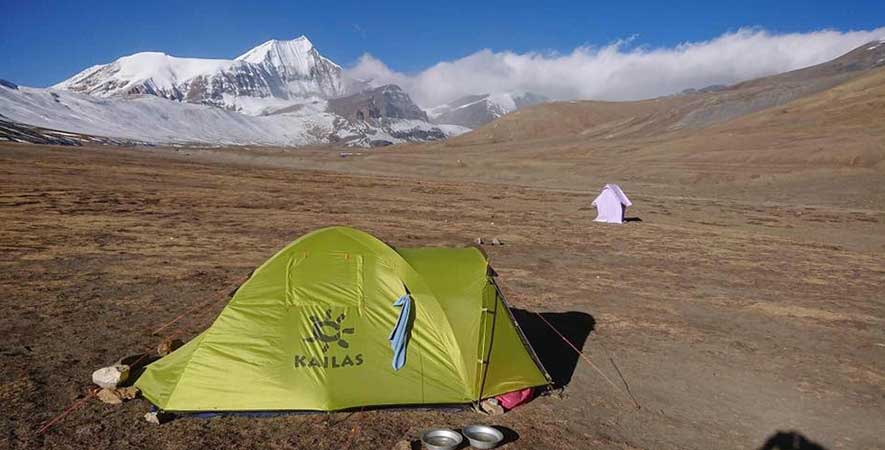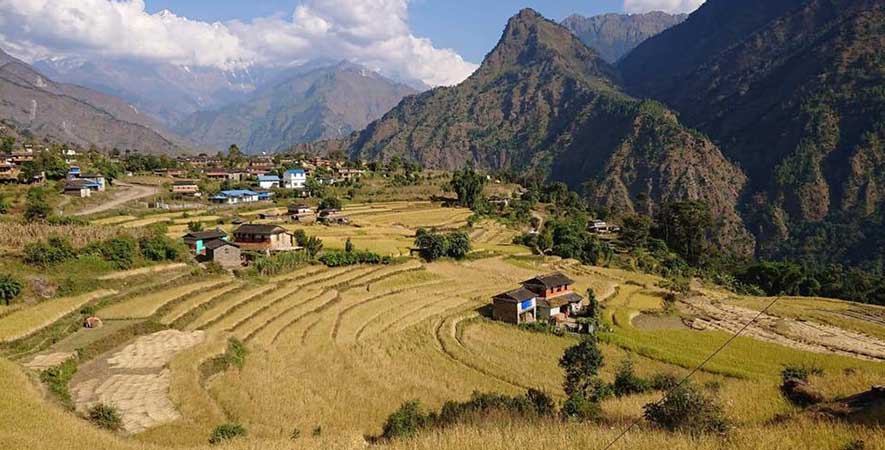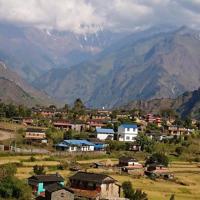

Email Us
contact@destinationhimalayatreks.com
Viber/Whats App 
+977-98510 16814 (Min Gurung)+977-98511 46814 (Tara Rana)
Round Dhaulagiri Trek
Trip Facts
Overview
Mount Dhaulagiri (8167m) is the 6th highest mountain in Nepal and the 7th highest in the world. Round Dhaulagiri Trek is one of the best treks around Mt. Dhaulagiri massif. It is along Mt. Annapurna zone which also provides the trek to the world’s deepest river gorge Kali Gandaki River and the picturesque view of the Dolpo region.
Round Dhaulagiri Trek is an adventurous trekking trail though most of the visitors choose the Everest region and Annapurna region for trekking. Trekking around Dhaulagiri gives you the chance of a close view of many high mountain peaks along with Mt. Dhaulagiri. The trek crosses two high passes- Thapa Pass/Dhampus Pass (5250m) and the French Pass (5360m) and many glaciers and snow walking while trekking from Italian Base Camp to Dhaulagiri North Base Camp.
Round Dhaulagiri Trek has the characteristic feature of a spectacular view of the giant Himalayan region. The trail is full of exciting explorations of the valleys, lush vegetation, people, and their day-to-day activities. Most of the route covers the snowy lands and wilderness but there is the enjoyment of shops, teahouses, villages, and hospitality of the people.
Dhaulagiri Area is adventurous and challenging because there are most often snow slides, icefall collapses, and danger of falling stones between the Italian and Japanese Camp. You may encounter semi-wild yaks on the trail. The route starts with terraced rice fields and gradually leads to rugged mountain landscapes. The trail from base camp to the ridge is steep and strenuously long till crossing the passes. Early start and early rest are compulsions because of the windy atmosphere in the afternoon.
Trekking around Mt. Dhaulagiri needs experience and an adventure- spirit. The company too should be of qualified climbers because the trek continues in snowfields for over a week. It needs to be prepared for rough weather that’s why a healthy and physically fit person can trek around Dhaulagiri Trek.
- High alpine pastures, hidden valleys, high windswept passes, forests, and cultivated terraced hills
- Trek to the world’s deepest river gorge Kali Gandaki River, a picturesque view of the Dolpo region
- Traverse French Pass and Thapa/ Dhampus Pass
- Explore remote farm villages inhabited by the Magar tribe
- Encounter semi-wild yak herds, mountain sheep, or the snow leopard
- Spectacular views of Tukuche Peak (6,920m), Dhaulagiri I (8,167m), Dhaulagiri II (7,751m), Dhaulagiri III (7,715m), and Dhaulagiri V (7,618m)
- Experience the rich, indigenous Thakali culture in Kaligandaki valley
Short Itinerary
Day 01: Kathmandu arrival, transfer to hotel
Day 02: Drive to Pokhara (840m)
Day 03: Drive to Darbang, trek to Dharapani (1560m)
Day 04: Dharapani to Muri.(1850m)
Day 05: Muri to Bolghara (2080m)
Day 06: Bolghara to Dobang (2520m)
Day 07: Dobang to Italian Base Camp (3660m)
Day 08: Rest Day
Day 09: Italian Base Camp to Glacier Camp (3730m)
Day 10: Glacier Camp to Dhaulagiri Base Camp (4750m)
Day 11: Rest Day
Day 12: Dhaulagiri Base Camp to Hidden Valley via French Pass (5360m)
Day 13: Hidden Valley to Yak Kharka via Dhampus Pass (5250m)
Day 14: Yak Kharka to Marpha to Jomsom
Day 15: Jomsom to Pokhara flight
Day 16: Pokhara drive to Kathmandu
Includes
- Land transportation as required for trip.
- All accommodation as mentioned program in Kathmandu.
- Camping gears
- A guide, special camping cook and supporting crews and porters.
- Foods and accommodation during the trek.
- All required permits for trekking
- Allowances for guide,cook and all crews and their trekking insurance.
- Emergency evacuation service in case needed.
Excludes
- All kind of bottle drinks.
- Personal and nature expenses.
- Your personal trekking gears.
- Rescue fee if in case...........
- Tips after trip to supporting crews.
Detail Itinerary
-
Day 01: Kathmandu arrival, transfer to hotel
Upon your arrival at the Tribhuvan International airport, the representative of Destination Himalaya treks gives you warm welcome in the adventurous Himalayan country Nepal. Overnight in a hotel.
-
Day 02: Drive to Pokhara (840m)
Today, we drive to Pokhara in a luxurious tourist bus and sightseeing through the attractive scene of the Nepalese countryside. This countryside offers various vegetation green forests, rivers, narrow, congested, roundabout roads, and very beautiful green hills. After reaching Pokhara (840m.), the representative of Destination Himalaya trek relocates you to the hotel.
-
Day 03: Drive to Darbang, trek to Dharapani (1560m)
After breakfast, drive to Darbang village via Beni. From here, the trekking journey starts to Dharapani. Traverse through a suspension bridge and start to ascend towards Dharapani. Adore the lovely surroundings and witness the first glimpse of Mt. Dhaulagiri on a bright day from here. Arrive at Dharapani for an overnight stay.
-
Day 04: Dharapani to Muri (1850m)
Walk through the traditional several villages enjoying the views of wheat-grown terraced fields. Also, get a sight of Gurja Himal, and Hiunchuli en route. Traverse a suspension bridge over Dhara Khola and reach the Magar-native Muri village. Overnight Stay.
-
Day 05: Muri to Bolghara (2080m)
Walk through the bamboo forest after descending from Muri and traversing a bridge over the Muri Khola. Continue to walk on a zigzag trail through the forest of oak and pine and arrive at Bolghara. Overnight Stay.
-
Day 06: Bolghara to Dobang (2520m)
Walk through the forested trail along the west bank of Myagdi Khola. Adore the terraced fields en route. Be careful while trekking as the altitude keeps on rising slowly. Keep continuing to trek until Dobang. Overnight Stay.
-
Day 07: Dobang to Italian Base Camp (3660m)
Walk through the beautiful birch, rhododendron, and pine trees forest and pass through Sallaghari. Also, pass through juniper trees walk a little further, and continue to ascend the trail. Pass through the moraine on the sideways and reach the Italian Base Camp. Overnight Stay.
-
Day 08: Rest Day
Italian Base Camp is scheduled as a rest day. It is necessary to prevent altitude sickness and adjust to the higher altitude. Spend the day exploring the nearby places or interacting with the crew or other trekkers. Overnight Stay.
-
Day 09: Italian Base Camp to Glacier Camp (3730m)
Walk on ascending steep trail and traverse along the moraine. Walk through the narrow gorge and continue for a few hours to reach Glacier Camp. Overnight Stay.
-
Day 10: Glacier Camp to Dhaulagiri Base Camp (4750m)
Walk on a rugged trail along the moraine towards Dhaulagiri Base Camp. Get an impressive view of Dhaulagiri I, Tukuche Peak, and other snowy mountains. Keep walking and set up a tent camp upon reaching the base camp. Overnight Stay.
-
Day 11: Rest Day
A much-needed rest day to allow our body to adjust to the altitude and prevent altitude sickness. The trek to the Hidden Valley via the highest French Pass is challenging. Thus, an acclimatization rest day is scheduled. The day is spent taking a training session on some mountaineering skills and the use of gears like ice ax, crampons, carabiners, fastening ropes, etc. Also, walk around nearby places. Overnight Stay.
-
Day 12: Dhaulagiri Base Camp to Hidden Valley via French Pass (5360m)
After breakfast, head toward Hidden Valley. Walk along the moraine strip and take left to traverse over the huge glacier. Follow the trail and arrive at the edge of French Pass. Get awesome views of Dhaulagiri I and Tukuche Peak. Go slow and carefully on a steep trail and finally reach the summit of French Pass. Get a sight of Buddhist prayer flags, and cairns, along with fantastic views of Dhaulagiri, Tukuche, Mukut Himal, Sita Chuchura, etc. After the amazing views, slowly descend and enter the Hidden Valley for an overnight stay.
-
Day 13: Hidden Valley to Yak Kharka via Dhampus Pass (5250m)
Another long day walks to reach Yak Kharka via Dhampus Pass. Start early and walk slowly on a sloppy trail and arrive at Dhampus Pass. Get a fabulous view of Dhampus Peak on the left and Tukuche Peak on the right. Slowly descend and take left and enjoy awesome views of Mt. Nilgiri, the west of Annapurna. Keep on descending on a steep trail and arrive at Yak Kharka. Overnight Stay.
-
Day 14: Yak Kharka to Marpha to Jomsom
A long day as we descend to Jomsom via Marpha. Marpha village is situated in the Kali Gandaki valley famous for its apple orchards. An easy descent walks on a steep trail to Marpha and continues to trek to Jomsom. Overnight Stay.
-
Day 15: Jomsom to Pokhara flight
We take a scenic flight to Pokhara. The rest of the day is spent exploring beautiful Pokhara City, especially Lake Side around Phewa Lake. Overnight in a hotel.
-
Day 16: Pokhara drive to Kathmandu
Enjoy a scenic ride and drive back to Kathmandu. Spend the rest of the time relaxing or exploring nearby places. Overnight in Kathmandu.
-
Dhaulagiri Trek Info
Accommodation and Duration
Round Dhaulagiri Trek is a camping trek. Mostly the days are spent in the tented camps. For the accommodation, the best quality tents for the kitchen, dining sleeping, & toilets, a gas stove for cooking meals & necessary cooking utensils, towels, hand wash soaps, toilet papers, and dining chairs & tables for eating are provided. The facilities are basic but the assurance of providing qualitative equipment makes the trip experience memorable. The trek duration is 16 days. Besides, tented camps, rest days are spent in the best hotels with maximum facilities.
Meals
During the camping treks, three-course full meals are provided, and only breakfast during your stay in the hotels. The experienced chef prepares healthy and hygienic food with high nutritional values to keep us energized throughout the trek. The staple diet of Nepali dal-bhat, vegetable curry, soups, eggs, bread, jam, porridge, herbal tea, ginger tea, coffee, noodles, seasonal vegetables, salads, etc., are served. You can enjoy continental cuisine during your stay in hotels and near city areas.
Drinking water
Drinking water during the trek is natural spring waters directly from the mountains. During the camping treks, boiled water is provided. Carry a handy water bottle and bring some water purification solutions or Steripen to purify the water.
Communication
Round Dhaulagiri Trek is completely a camping trek. Thus, there is little or no chance of communication facilities. The communications like phone or Wi-Fi signals are there in the cities and no internet access during the trek. The remoteness and no communication for longer days make this trek experience unique for trekkers. Spend some quality time far from the busy world, and connections in the lap of mountains and the vicinity of nature. Bring solar power banks for charging the camera and phone.
Starting and Ending points
Darbang Village is the starting point of the trek after a short drive from Beni. The ending part of the trek is Jomsom. From Jomsom, return to Kathmandu or Pokhara via flight.
Permits Required
All treks in the mountains of Nepal require permits. ACAP and TIMS permits are required for Round Dhaulagiri Trek.
ACAP permit cost charge: NPR 3000 (Foreigners), NPR 1000 (SAARC)
TIMS permit cost charge: NPR 2000 (Foreigners), NPR 600 (SAARC)
Travel Insurance
Travel Insurance is a safeguarding tool for all travelers/trekkers. The insurance must cover all medical emergencies, helicopter rescue, air ambulance, flight cancelations, loss/theft of luggage, personal expenses, cover repatriation, evacuations, and altitude sickness. Get travel insurance from a trusted insurance company for easy future claims. It helps trekkers against unforeseen emergencies. Bring yourself a copy of the insurance and provide us a copy for quick arrangements in case of emergencies.
Safety and our guides
We assure you 100% when it comes to safety. Our client’s safety is our main concern. Our guides are certified and well-trained with years of expertise in this field. They are technically competent and have excelled in safety performance. They always carry essential safety equipment, gear, and first-aid kits. For the safety of our trekkers, the itinerary is properly scheduled and acclimatization rest days are properly set up to adjust to the high altitude and prevent altitude sickness. If any queries concerning safety, feel free to share them with our guides. We are always there for your services.
Best time to Round Dhaulagiri Trek
The summer and autumn seasons are the best for Round Dhaulagiri Trek. Since most of the days are spent in a tent camp, Sep-mid Nov and Mar-May months are suitable for trekking. Round Dhaulagiri Trek is challenging and requires good physical fitness and appropriate months to accomplish the trek. Winter and Monsoon seasons are off-season and only a few trekkers dare to trek around. These seasons are not favorable as the climatic condition changes drastically and is full of risks. We recommend trekking only during the season to experience great weather, stunning views, blossoming flora, and clear blue skies.
Round Dhaulagiri Trek Difficulty
Round Dhaulagiri Trek has several challenges of high altitude, steep ascend & descend, rough terrains, rocky trails, and frequent climatic changes making it tough for the trekkers. During this trek, the highest pass to traverse is French Pass at an elevation of 5360m. The trek is difficult due to the high passes at high altitudes and it is a fully camping trek. Also, the trekking route is remote and the least crowded compared to the Everest and Annapurna treks. Thus, this region has very limited facilities. It is better to be prepared mentally and trained physically for months before starting the Round Dhaulagiri Trek. Consult with a doctor and be in good health condition. Start training yourself with physical exercises like swimming, cycling, running, day hiking, etc., and be physically fit and mentally sound. Eat healthy diet foods besides physical exercise.
Acclimatization and Altitude Sickness at Round Dhaulagiri Trek
Round Dhaulagiri Trek is a challenging trek. Thus, there is a high chance of getting altitude sickness as trekkers must pass several high passes above 3000m. Italian Base Camp (3660m) and Dhaulagiri Base Camp (4750m) are scheduled as rest/acclimatization days. Altitude sickness is normal above 3000m and proper precautions must be taken.
Symptoms of Altitude Sickness
Primary: Headache, nausea, gasping, appetite & sleep loss, dizziness, fatigue, vomiting
Extreme: primary symptoms and hallucinations & unconsciousnessPreventive Guidelines
- Immediately inform the guide
- Warm-up, and body stretch before the trekking journey
- Drink water and Hydrate yourself at regular intervals
- Frequent urination throughout the journey
- Ascend slowly and gradually
- Take plenty of rest and sleep
- Avoid salty foods, alcohol, and smoking
- Descend immediately when it’s difficult/uneasy
- Take medicine consulting a guide
Luggage limitation for Porter
The luggage limitation per person is a maximum of 15 kg. One porter carries the luggage of two trekkers. The luggage limitation is done considering the health of the porters.
Food: Energy bars, light snacks (cookies, snickers, etc.), Energy drink mix
Essential Documents: Passport, Travel Permits
Shoes: Pair of hiking boots, Rubber sandals, Camp shoes
Clothes: Windcheater jacket, Thermals, Insulating Down Jacket, Fleece, Long sleeve shirts, Gloves, Towels, Inner garments, Trekking pants, Trousers, Shorts, Socks, Raincoat, Balaclava, Bandana, Gaiters
Accessories: Sunglasses, Hats/Caps, Sunscreen, Lip Balm, Water bottles, Pocket Knife, Solar chargers, Batteries, Torch, Umbrella, Sewing kit, Water Purifying solution/Steripen
Equipment & Gears: Warm Sleeping bags, Map, Trekking poles, Duffel bag, Carabiners, Crampons, Tapes/Slings, Ice Screws, Ice Ax, Harness, Rope, Spikes
Medicine: First-Aid Kit, Altitude sickness medicines, Insect repellents
Rainy season: Waterproof clothes, boots, Raincoat, Anti-leech socks
Winter Season: Woolen clothing items (light)
Personal Hygiene Kit: Hand sanitizer, wet wipes, napkins, sachet shampoo, moisturizer, hand wash/soaps, toothbrush, toothpaste, comb/brush, razor, and for ladies (tampons/sanitary pads/menstrual cups)
It is best to bring the clothes and essential equipment from your home from the provided checklist. Also, you can buy or rent equipment and clothes in Kathmandu. Don’t forget to carry extra 2-4 reusable bags to separate used/dirty and clean clothes.


